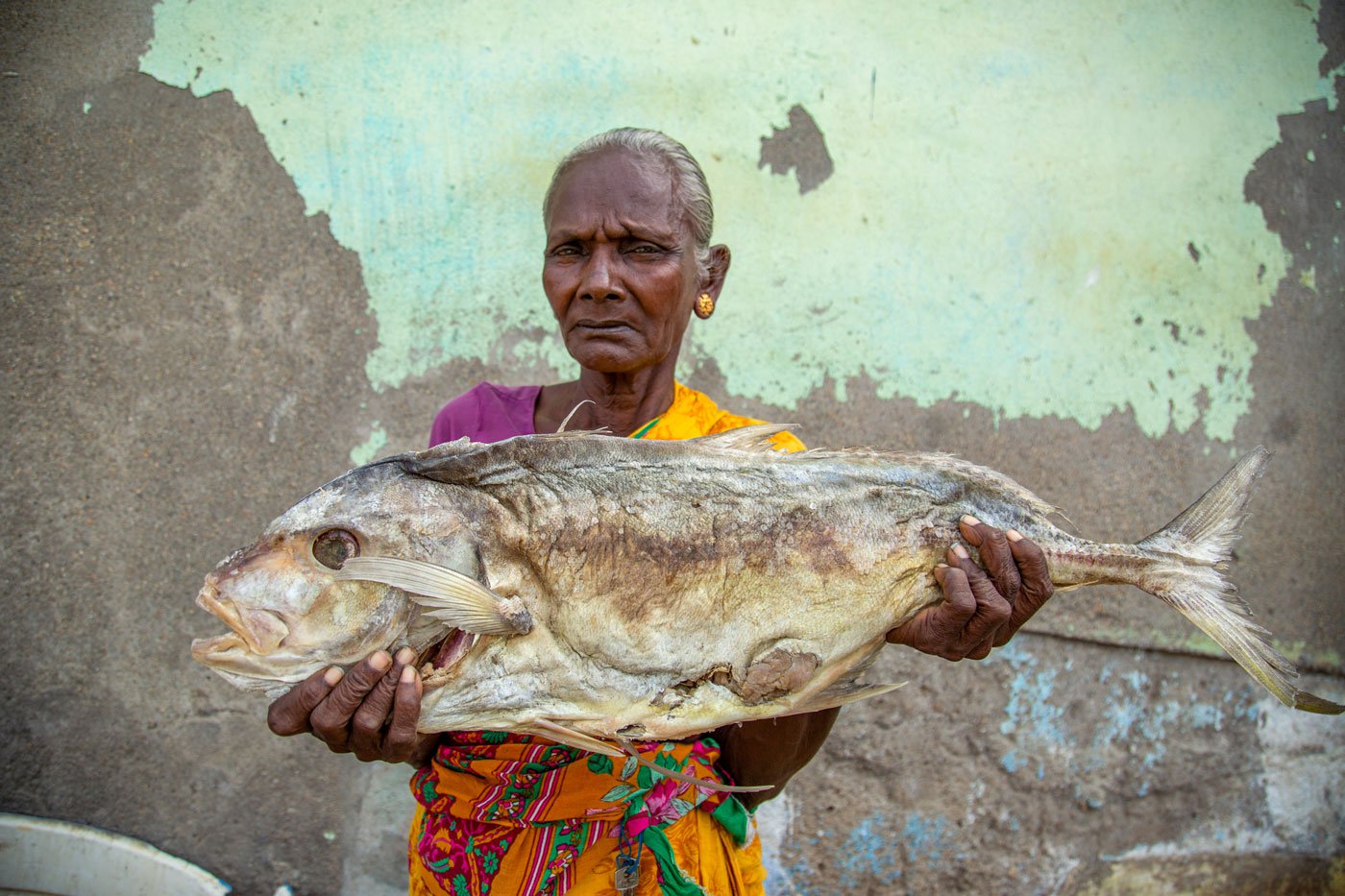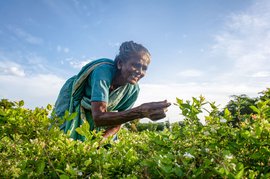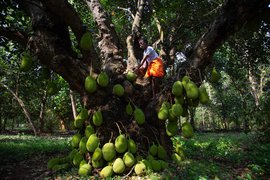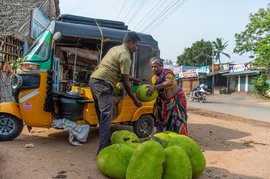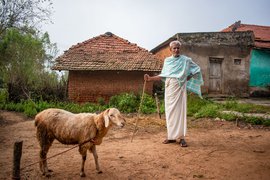It’s an unexpected magic show. From an old blue box at the back of her shop, D. Fathima brings out treasures. Each one is a work of art: big, strong fish, that lived in the deep sea beyond Thoothukudi, now dried and preserved by sun, salt and skilled hands.
Fathima lifts a katta paarai meen (queen fish) and holds it near her face. It’s half her height and its throat is as wide as her hands. A deep gash runs from its mouth to tail, where she has split the plump flesh with a sharp knife, removing the entrails, stuffing the katta paarai with salt, and laying it under a sun so fierce, it dries everything it shines on: fish, earth and people...
The lines on her face and hands tell that scorching story. But she begins another. Of a different era, when her aachi (grandmother), salted and sold fish. Of a different city and street, when the canal across the road was just a few feet wide, right beside their old home. And of the tsunami in 2004, which brought in sludge and sewage into their lives, and with it, the promise of a new home. But there was one problem. The purpose-built house was “ rombha dhooram [very far],” Fathima says, tilting her head and raising a hand to indicate the distance. It took them about half an hour by bus, and they had to come to the seashore anyway, to purchase fish.
Nine years later, Fathima and her sisters came back to their old neighbourhood – Therespuram, a locality on the edge of Thoothukudi town. The house and shop are next to a now-widened canal, where water flows sluggishly. The afternoon is still: as still as the dried fish that preserve the women’s lives with some salt and a lot of sun.
Fathima, 64, was in her grandmother’s fish trade until she got married. She returned to it again after her husband died over two decades ago. When she was eight years old, Fathima remembers the fish trembling and quivering with life when the nets were brought to the shore – so fresh was the catch. Nearly 56 years later, it is all ‘ice meen [fish] , ’, she points out. The boats carry ice to pack the fish and bring it back. The sale of big fish runs into lakhs of rupees. “Back then, we dealt with annas, paise, one hundred rupees was big money, now it’s thousands and lakhs.”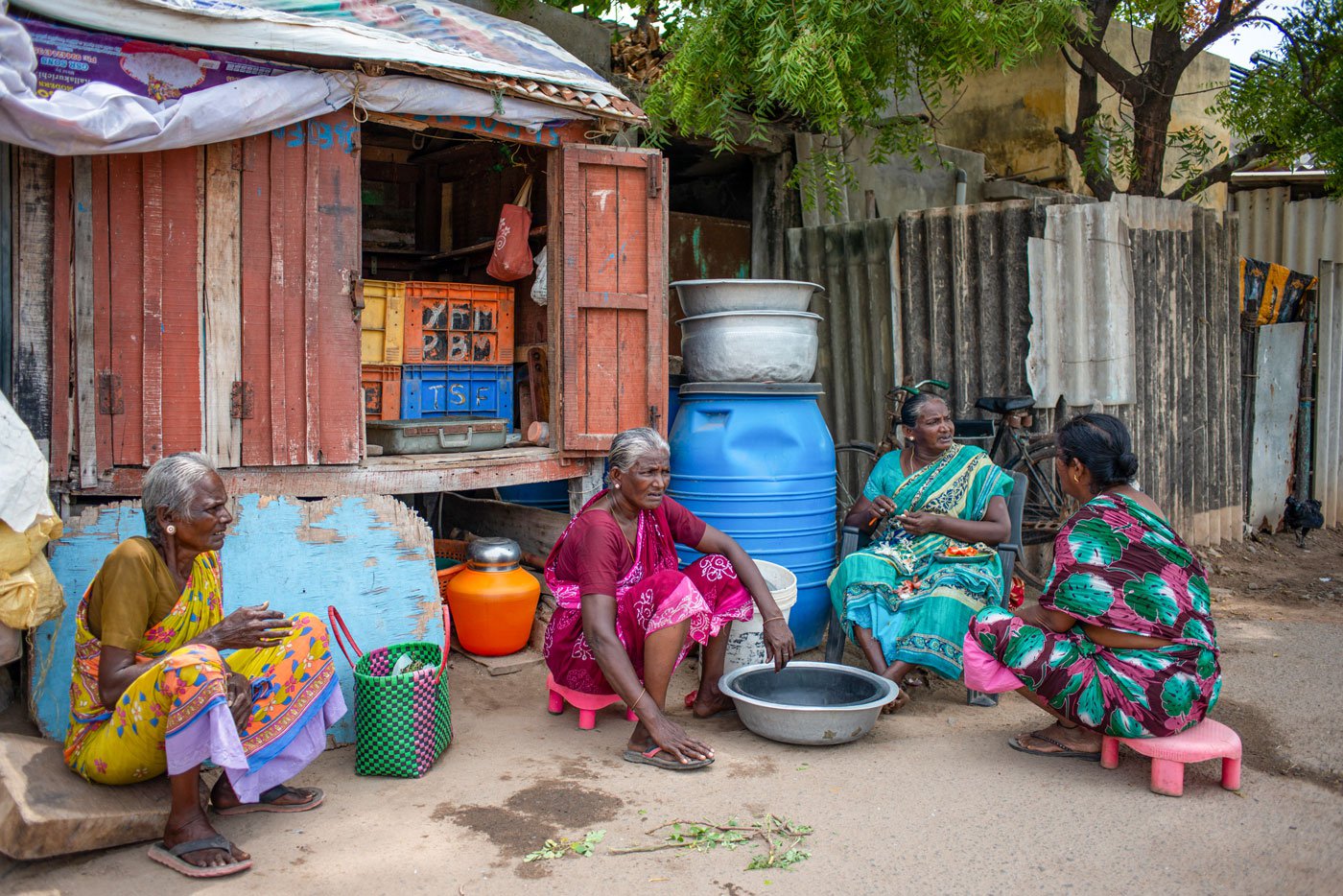
Fathima and her sisters outside their shop
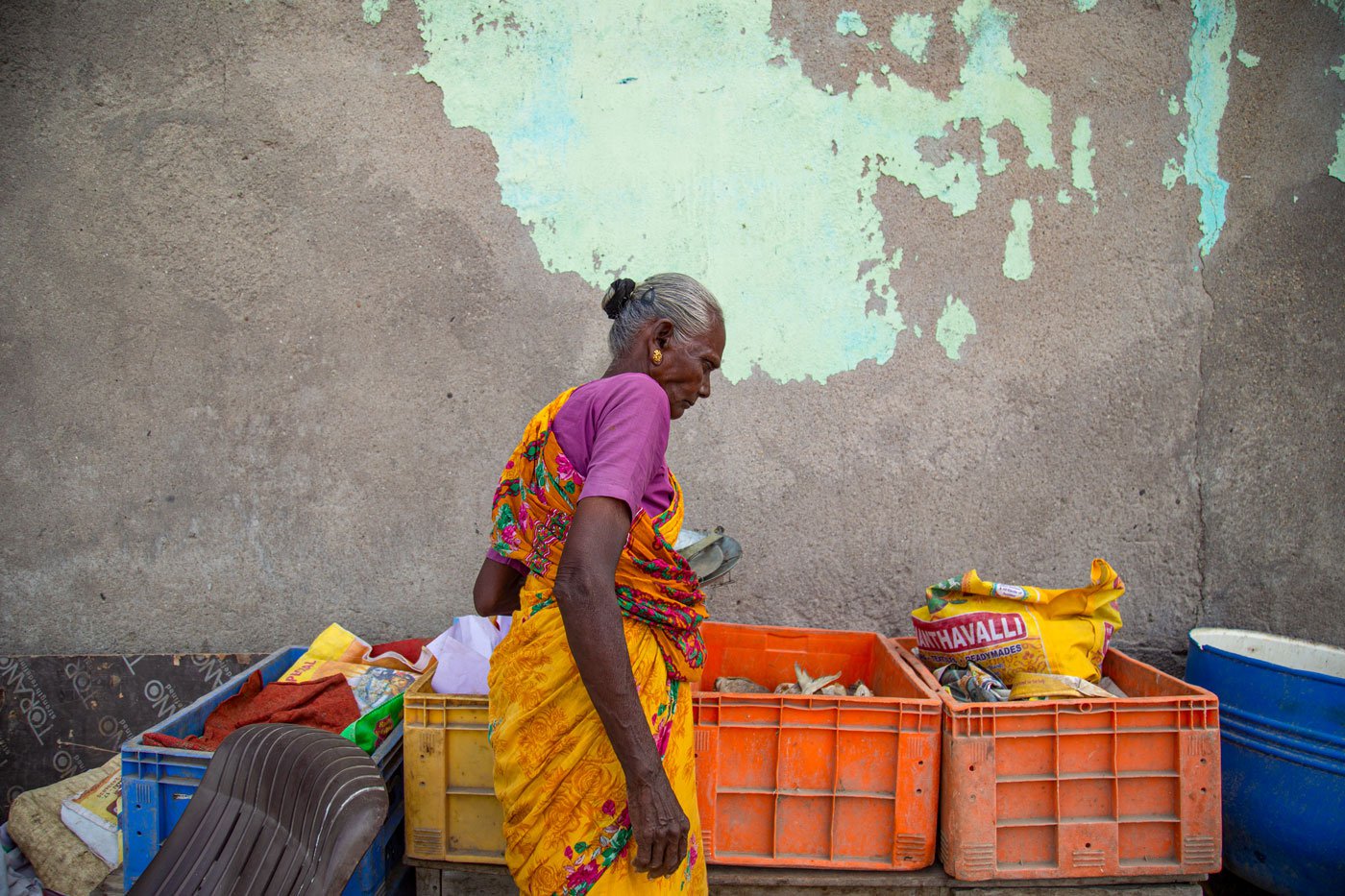
Fathima inspecting her wares
In her aachi ’s time, the women walked everywhere. With a headload of dried fish in a palm leaf basket. “They walked 10 kilometres and went to pattikaadu (hamlets) to sell their produce.” Now they carry the dried fish in an aluminium basket and travel by bus to sell it. They go all the way to villages in neighbouring blocks and districts.
“Before corona, we would go to villages on the Tirunelveli road, on the Thiruchendur road,” Fathima’s hands drew a map of the region in the air, when PARI met her in August 2022. “Lately, we only go to a santhai [weekly market] in Eral town, every Monday.” She calculates her travel costs: two hundred rupees, including the auto fare to the bus-depot and the full ticket for her basket in the bus. “Plus, I pay five hundred [rupees] as entry fee for the market. We sit under the sun [in the open], but that’s the rate.” She thinks it’s worth her while though, as she sells between five and seven thousand rupees worth of dried fish there.
But four Mondays do not make a month. Fathima is clear-eyed about the problems of the trade. “A few decades ago, fishermen didn’t have to go far from Thoothukudi; they would come back with a big catch. Now? They cross the high seas and yet there’s not much of a haul.”
Drawing from her lived experience, Fathima sums up the depletion in fish stocks in under a minute. “Back then, they would go in the night and return the next evening. Today, they go for 15-20 days, all the way to Kanyakumari, near Ceylon and the Andamans.”
It’s a huge area and, indicates a widespread problem: dwindling catch in the fishing grounds near Thoothukudi. One she has no control over. But which fully controls her life. And livelihood.
The phenomenon that Fathima talks about has a name: overfishing. Look it up on Google, and you’ll find some 18 million answers in a fraction of a second. It’s that common. And that’s because, as a Food & Agriculture Organisation (FAO) of the United Nations report says “globally, aquatic foods provided about 17 per cent of animal proteins and 7 per cent of all proteins in 2019.” That is, every year, we extract “80 to 90 million metric tons of wild seafood from the ocean,” says Paul Greenberg, author of American Catch and Four Fish. And this is staggering because Greenberg says it is the “equivalent to the human weight of China .”
But here’s the catch. Not every fish is eaten fresh. Like other meat and vegetables, it is preserved for future use. And among the oldest methods is salting and sun drying.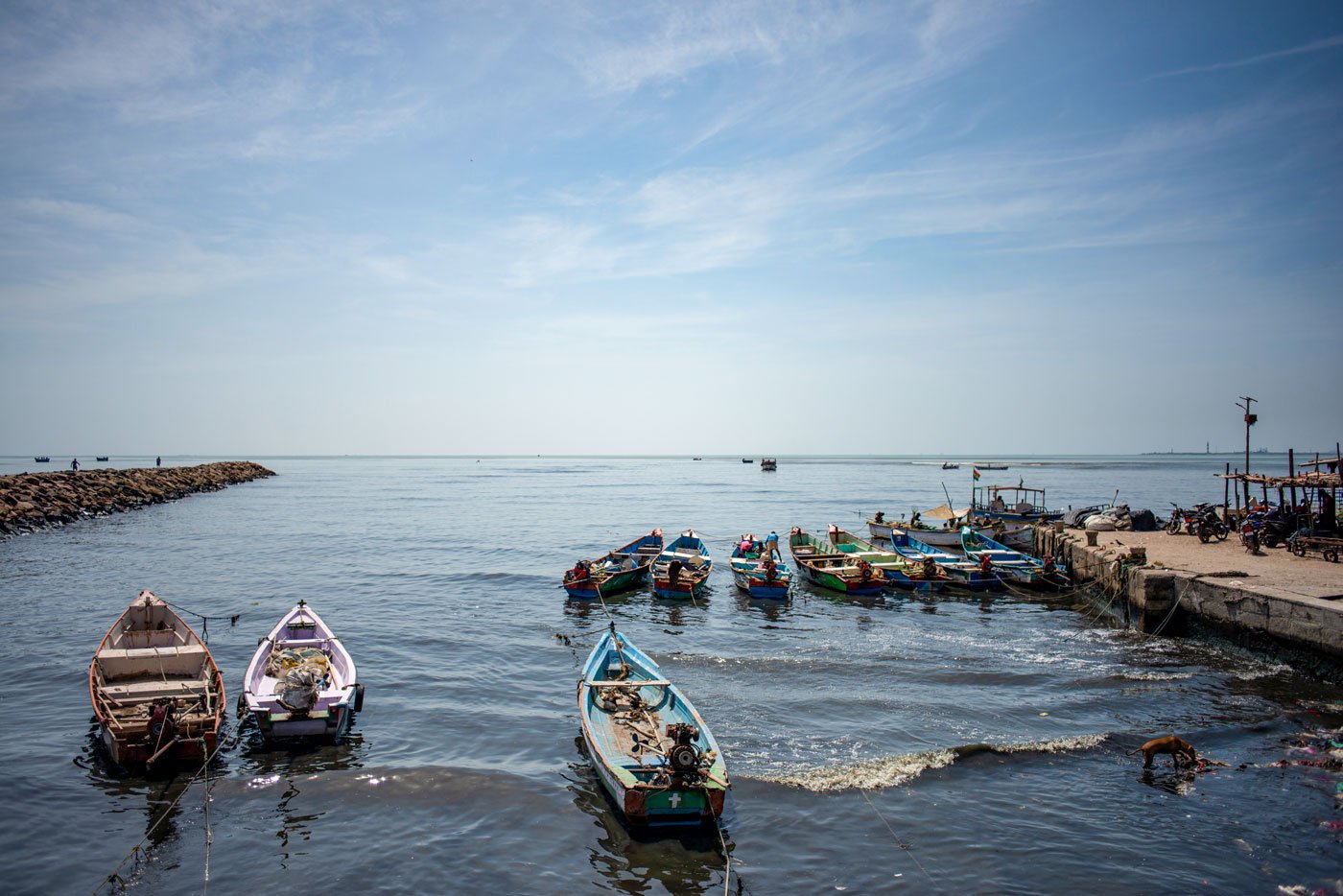
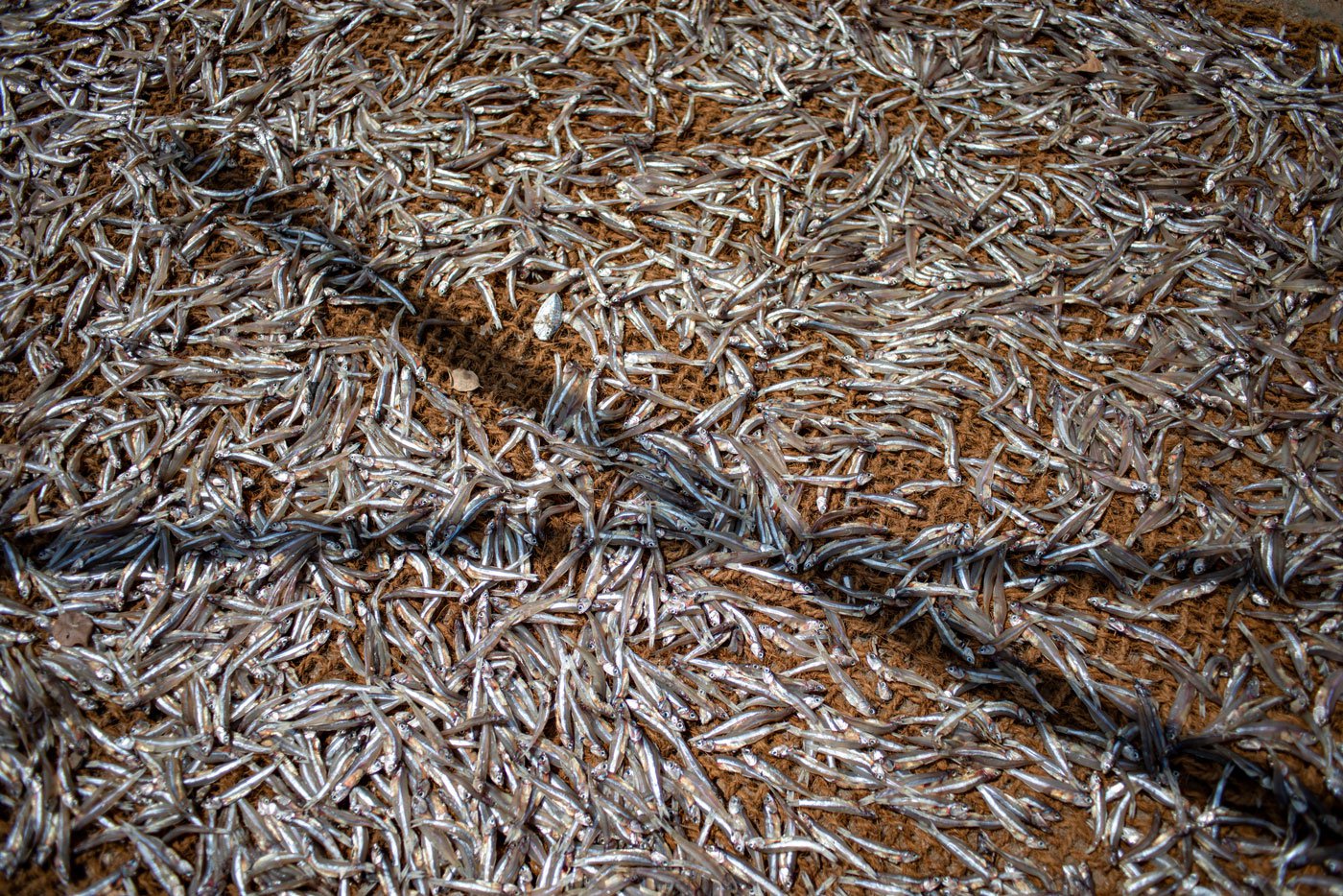
Left: Boats docked near the Therespuram harbour. Right: Nethili meen (anchovies) drying in the sun
*****
come desiring the fatty, shark meat
pieces we spread out to dry.
Of what use is your virtue to us?
We reek of fish! Go away from here!
Natrinai 45 , Neythal Thinai (songs from the seashore)
Poet unknown. What the heroine’s friend said to the hero.
This timeless classic is part of the 2,000-year-old Tamil Sangam canon. Plus, it has several interesting references to salt merchants and their wagons travelling up from the coast. Do similar traditions of salting and sun-drying exist in other ancient cultures?
Yes, says Dr. Krishnendu Ray, Food Studies scholar. “Outward-oriented, especially seafaring empires probably had a very different relationship to fishing. Partly because the craft of building boats and the skilled labour of manning them, so necessary for these empires, came mostly from fisherfolk, as one sees much later in the Viking, Genoese, Venetian, Portuguese, and Spanish cases.”
The professor from New York University continues saying, “before refrigeration, salting, air drying, smoking, and fermentation (as fish sauce) would be the only ways to preserve the highly valuable proteins; to conquer time and distance so necessary for long-distance ship provisioning. Hence the Roman Empire, around the Mediterranean, highly valued garum [fermented fish sauce], that vanished from view with the collapse of Rome.”
Artisanal processing, of the sort common in Tamil Nadu, as another FAO report notes “generally involves destroying spoilage bacteria and enzymes and creating conditions which are unsuitable for microbial growth and proliferation.”
Salted and sun dried fish
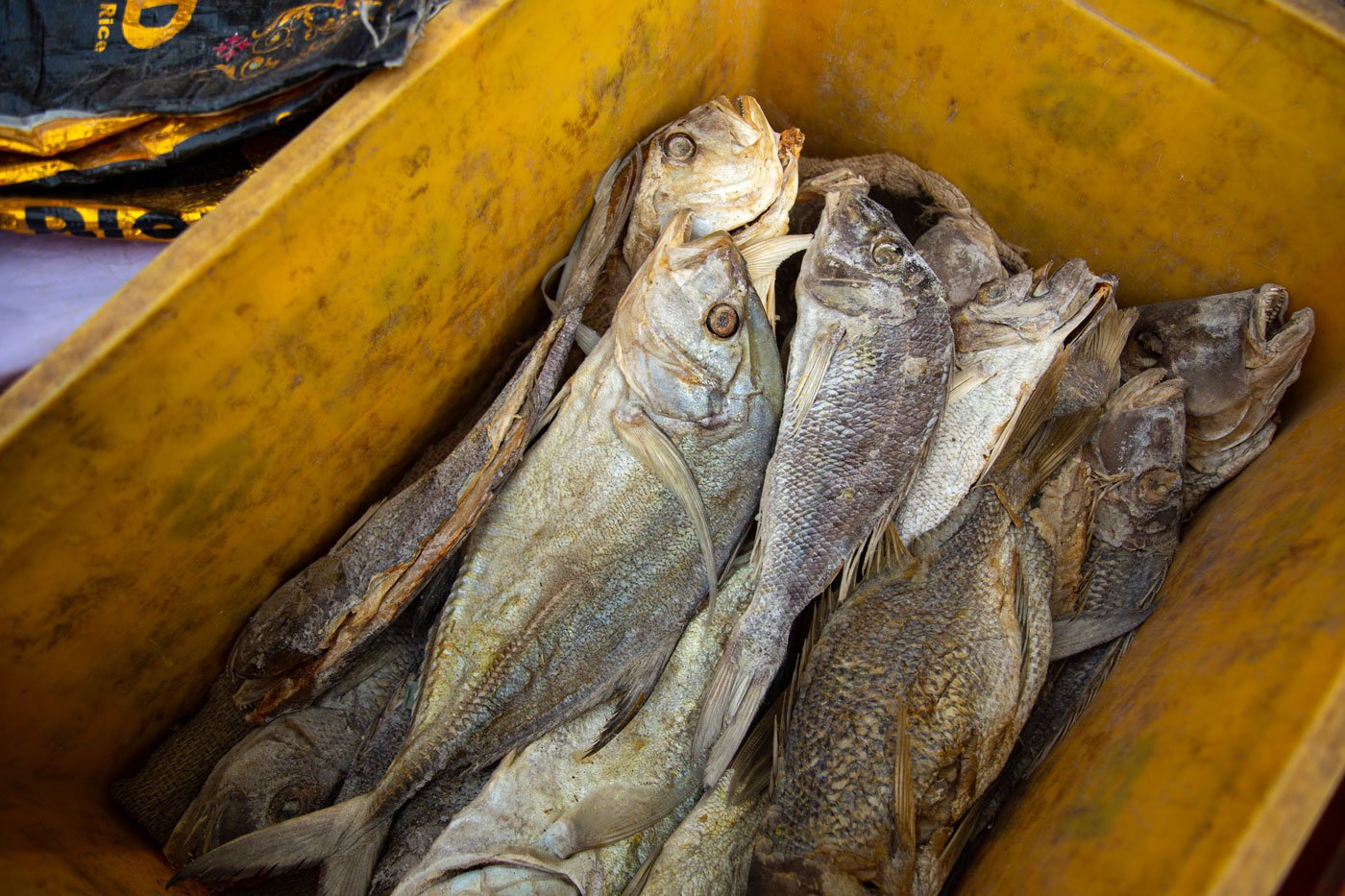
Karuvadu
stored in containers in Fathima's shop
Salted fish, the FAO report goes on to say, “is a low-cost form of fish preservation. There are two common methods of salting: dry salting, whereby salt is applied directly onto the fish surface; and, brining, whereby the fish are immersed in a salt/water solution.” And they keep for many months.
Despite the hoary past, and in spite of being an affordable and easily available source of protein, Karuvadu comes in for much ridicule in popular culture [for instance, in Tamil cinema]. Where does it fit in the hierarchy of taste?
Dr. Ray says “there are layers of hierarchical thinking involved. Wherever hegemonic forms of terrestriality have spread – along with certain forms of Brahmanism – there is a great deprecation and suspicion of lives and livelihoods dependent on water, especially salt water… As caste was produced in some relationship to territory and occupation, fishing was marginalized.”
Fish, says Dr. Ray, “is the last wild thing we catch and eat intensively. It can be highly valued for that or disdained. In many parts of Sanskritized India it came to be disdained where territoriality, domesticity, and grain production with the related investment in arable land, temple investment, and hydraulic infrastructure came to be valued as an economic and a cultural good.”*****
In the small shadow of a sunshade, Sahayapurani prepares a poomeen [milk fish] . Sarr, sarr, sarr – her knife scrapes the three-kilo fish that she bought for 300 rupees at the Therespuram auction centre. Her workplace is across the canal from Fathima’s shop. The canal water is dark, more sludge than stream. The scales from the fish fly everywhere – some fall around the Poomeen fish, and some leap, catching the light and land two feet away on me. She looks up and laughs when they hit my dress. Hers is a quick and easy laughter. And we all join in. Sahayapurani resumes her work. Two neat cuts and the fins are off. Next, she slices the fish’s neck, and chops it with a sickle. Thud, thud, thud - six times – and the head is severed.
A white dog tied behind her looks on, its tongue lolling in the heat. Next, Sahayapurani removes the gut, and pierces the flesh with the knife and opens the fish like a book. With the sickle, she makes deep grooves into the muscle. With the knife, she makes smaller, thinner lines. With one hand, she takes fistfuls of salt and rubs them into the fish, filling the gashes, until the pink flesh is studded with white crystals. The fish is ready to be dried. She washes the sickle and the knife, dips her hands in the water and wrings them dry. “Come,” she says. We follow her home.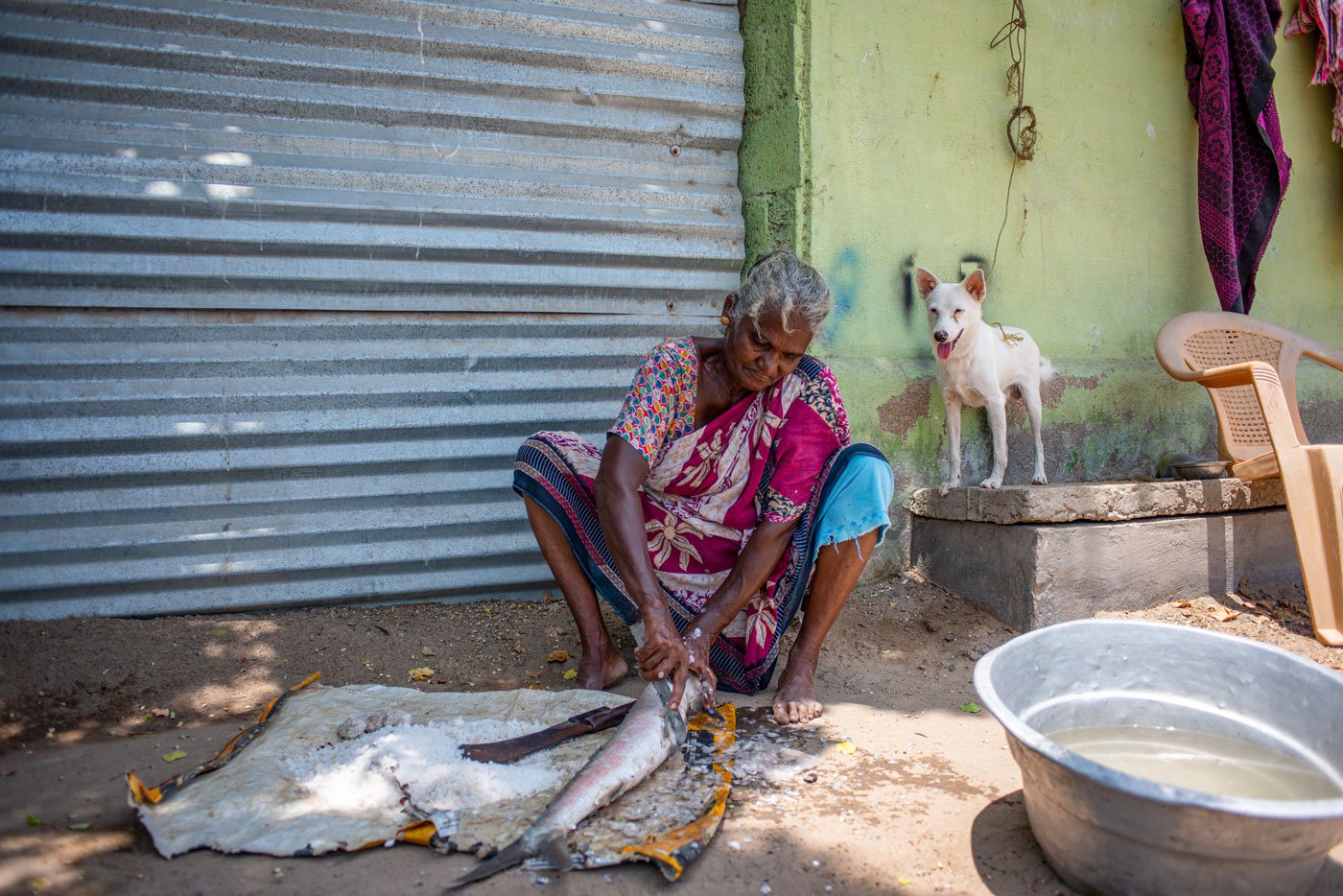
Sahayapurani scrapes off the scales of
Poomeen karuvadu
as her neighbour's dog watches on
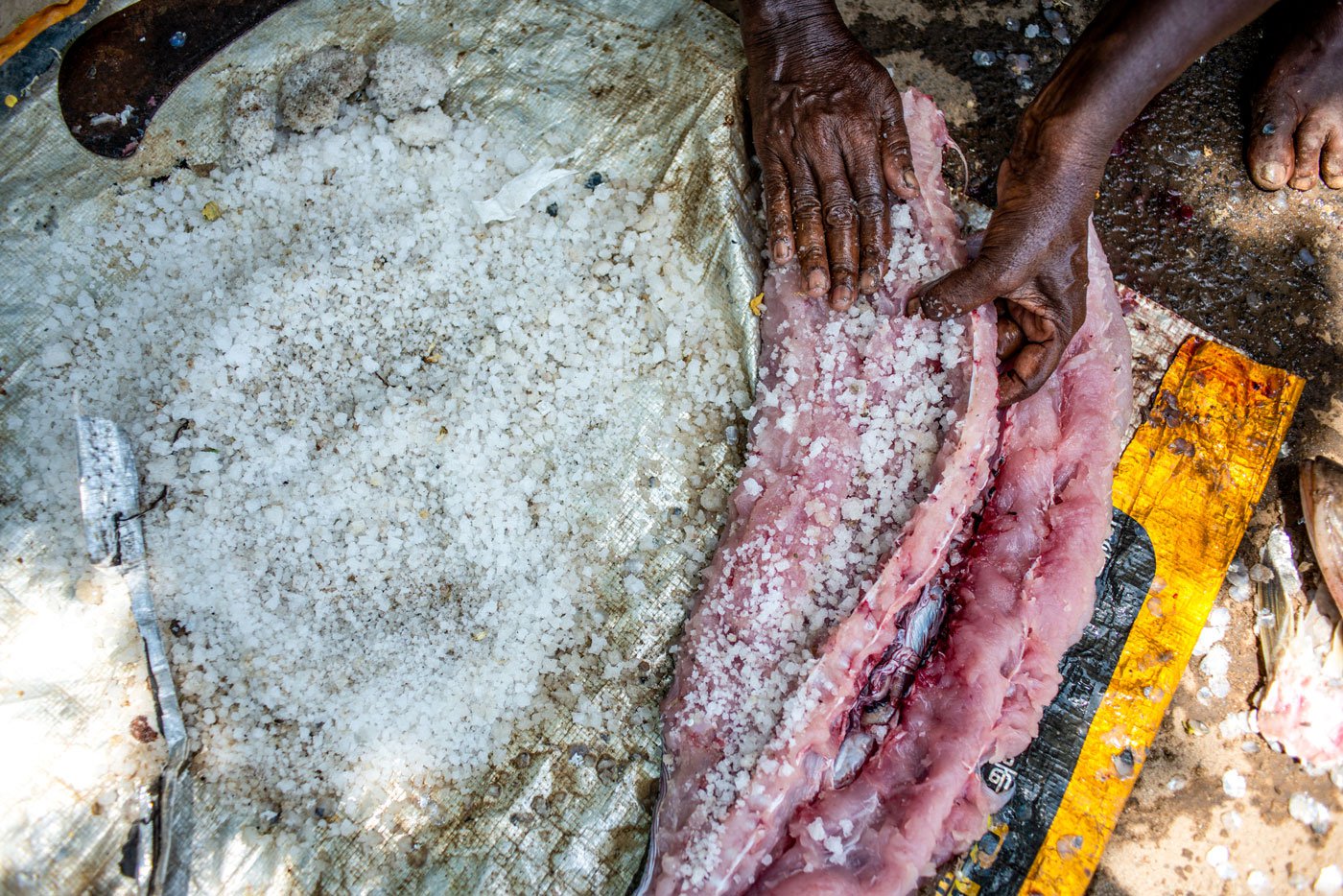
Sahayapurani rubs salt into the poomeen 's soft pink flesh
The Marine Fisheries Census 2016 , Tamil Nadu informs us that there are 2.62 lakh women and 2.74 lakh men among the fisherfolk in the state. It also reveals that fully 91 per cent of marine fishermen families fall below the poverty line (BPL).
Seated away from the glare of the sun, I ask Sahayapurani how much she sells in a day. “It all depends on what Andavar [Jesus] has planned for us. We are living because of his grace.” Jesus makes many appearances in our conversation. “If he helps sell all the dried fish, we will come home by 10:30 a.m.”
Her quiet acceptance extends to her workspace. Her designated place to dry the fish is by the canal. It’s far from ideal, she says, but what’s the alternative? It’s not just the scorching sun, she along with her wares are exposed to untimely rains too. “The other day, I salted the fish and put them out to dry and came home and closed my eyes for a bit… suddenly a man came running and said it is raining, I hurried out, but half the batch was soaked. You can’t salvage small fish, they get spoilt, you know.”
Sahayapurani, who is now 67 years old, learnt the art of drying fish from her chithi - her mother’s younger sister. But, she says, while there is visibly more trade in fish, the consumption of dried fish is in decline. “That’s because those who wish to eat fish, can easily buy fresh stock. They sell it cheap sometimes. Besides, you don’t want to eat the same thing every day, do you? If you have fish twice a week, then you have biriyani one day, sambhar another, rasam , soya biriyani and so on…”
The main reason though, is conflicting medical opinion. “Don’t eat karuvadu , it is too salty. Doctors say it increases blood pressure. So, people shun this.” When she explains the drop in trade and doctors’ advice, she shakes her head slowly, and pushes out her lower lip. It is a child-like expression, which captures both disappointment and vulnerability at once.
When the karuvadu is ready, she stores it in her house, in the next room, allocated for the trade. “Large fish typically last for months,” she says. She’s confident of her skills; the way she runs grooves and rubs salt ensures that it will stay. “Customers can keep it for several weeks. If you add a little turmeric and some salt and wrap it in newspaper and then put it in an airtight cover, you can keep it for a long time in the fridge.”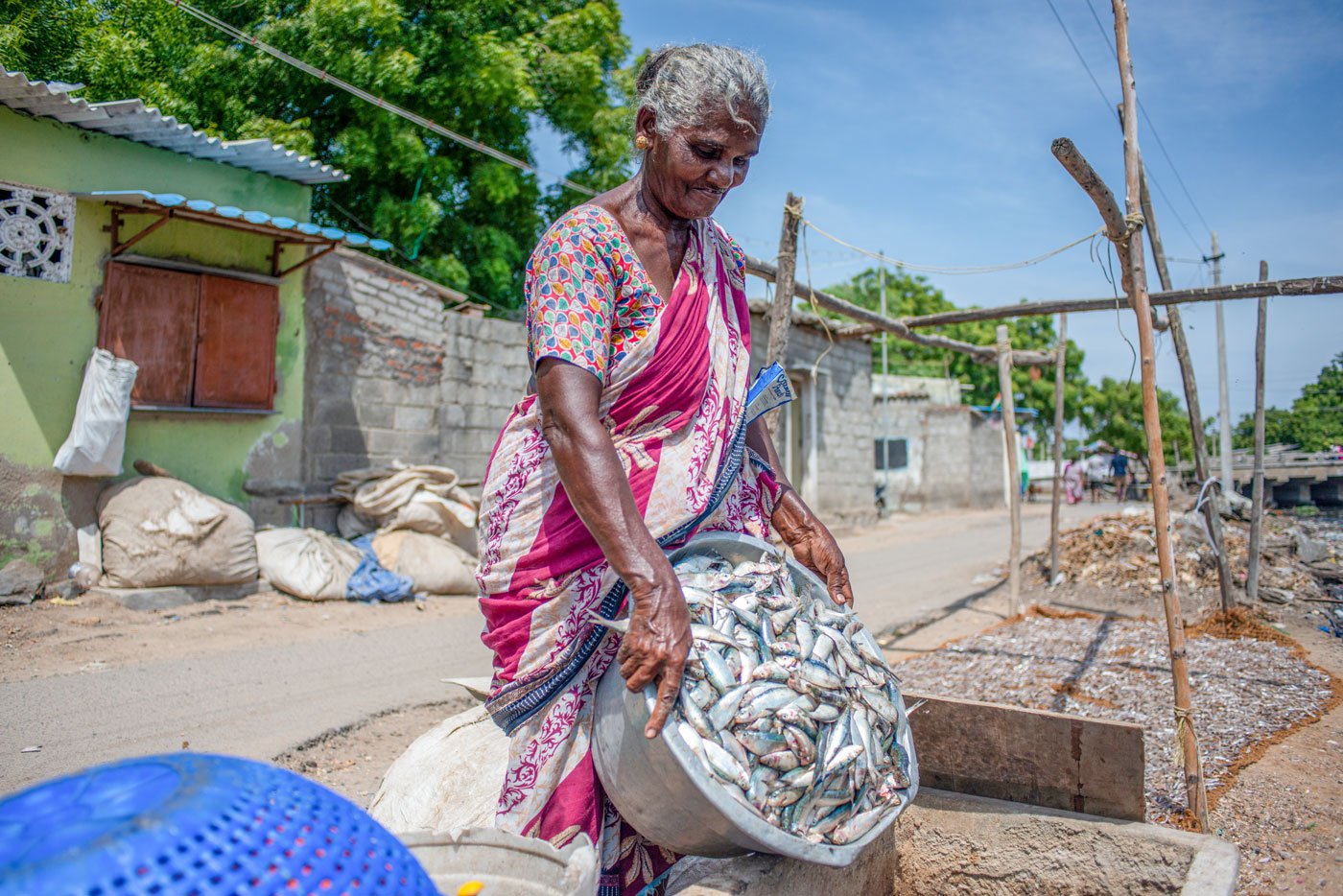
Sahayapurani transferring fishes from her morning lot into a box. The salt and ice inside will help cure it
In her mother’s time, they ate karuvadu more often. Dried fish were fried and eaten with millet porridge. “They took a big pot and added some drumstick and brinjal and fish and made a gravy and poured it over the porridge. But now, everything is ‘neat’,” she laughs loudly, “why, even the rice is ‘neat,’ and people have vegetable kootu [cooked together with pulses], and fried eggs as sides. I had never heard of vegetable kootu 40 years ago.”
Most days, Sahayapurani leaves home at 4:30 a.m. travelling by bus to villages within a 15-kilometre radius. “We get a free ride in the pink buses,” she says, referring to the government of Tamil Nadu’s scheme of free bus rides for women announced by chief minister M.K. Stalin in 2021. “But we pay a full ticket for our basket. That could be 10 rupees, or 24. It depends.” She also slips in a tenner to the conductor occasionally. “He is more courteous then,” she grins.
When she reaches her destination, Sahayapurani walks around the village and sells the fish. It’s a hard, heavy, job, she concedes. And competitive. “It was worse when we sold fresh fish. Men would bring baskets of fish in two-wheelers and cover ten houses in the time we walked to two. The vehicle cut their drudgery. Our walk was punishing, plus, the men undercut us all the time.” So, she kept to selling karuvadu .
The demand for dried fish varies with the season. “When there are village festivals, people abstain from meat for days and weeks sometimes. If many people observe that practice, it definitely impacts our sales.” And this is new, Sahayapurani says. “Five years ago, I did not see so many people taking these religious vows.” During and after the festival – when goats are sacrificed for a feast – people order good quantities of dry fish for their relatives. “They even ask for one kilo sometimes,” her daughter Nancy, 36, explains.
During the lean months, the family survive on loans. “Ten paise interest, daily interest, weekly interest, monthly interest. That’s how we live during the monsoon and during the fishing ban. Some pledge jewellery. Either at pawn shops or at the bank. We have to borrow,” says Nancy, who is a social worker. Her mother completes Nancy’s sentence, “To buy food.”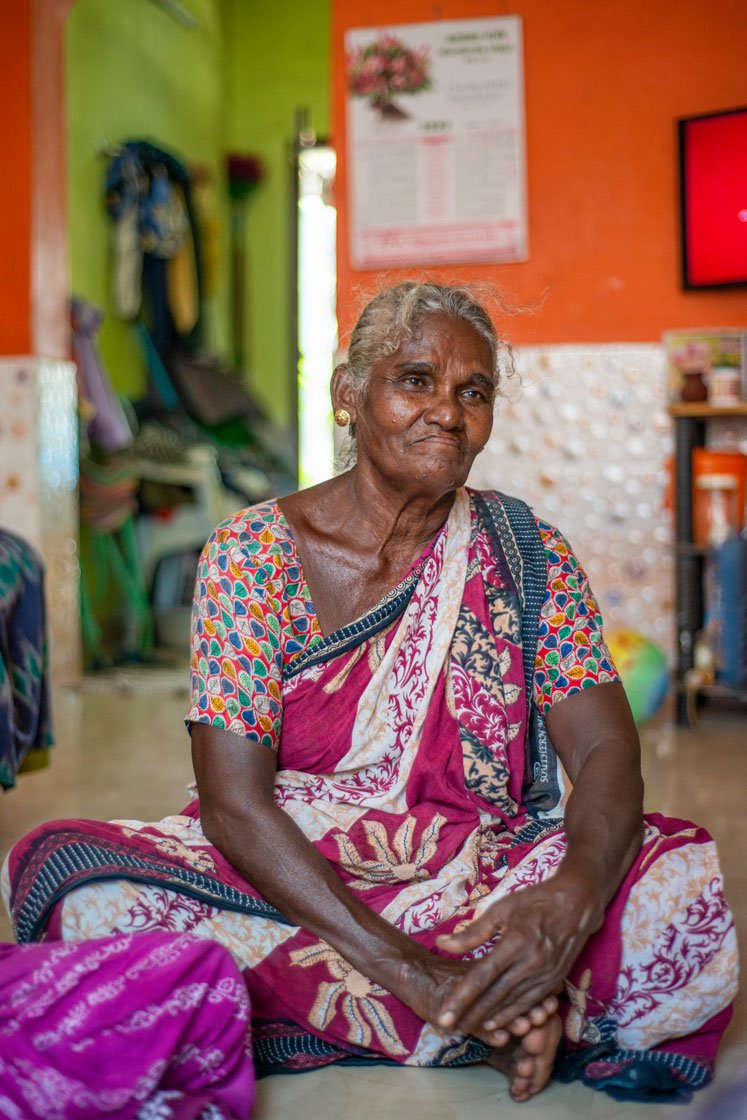
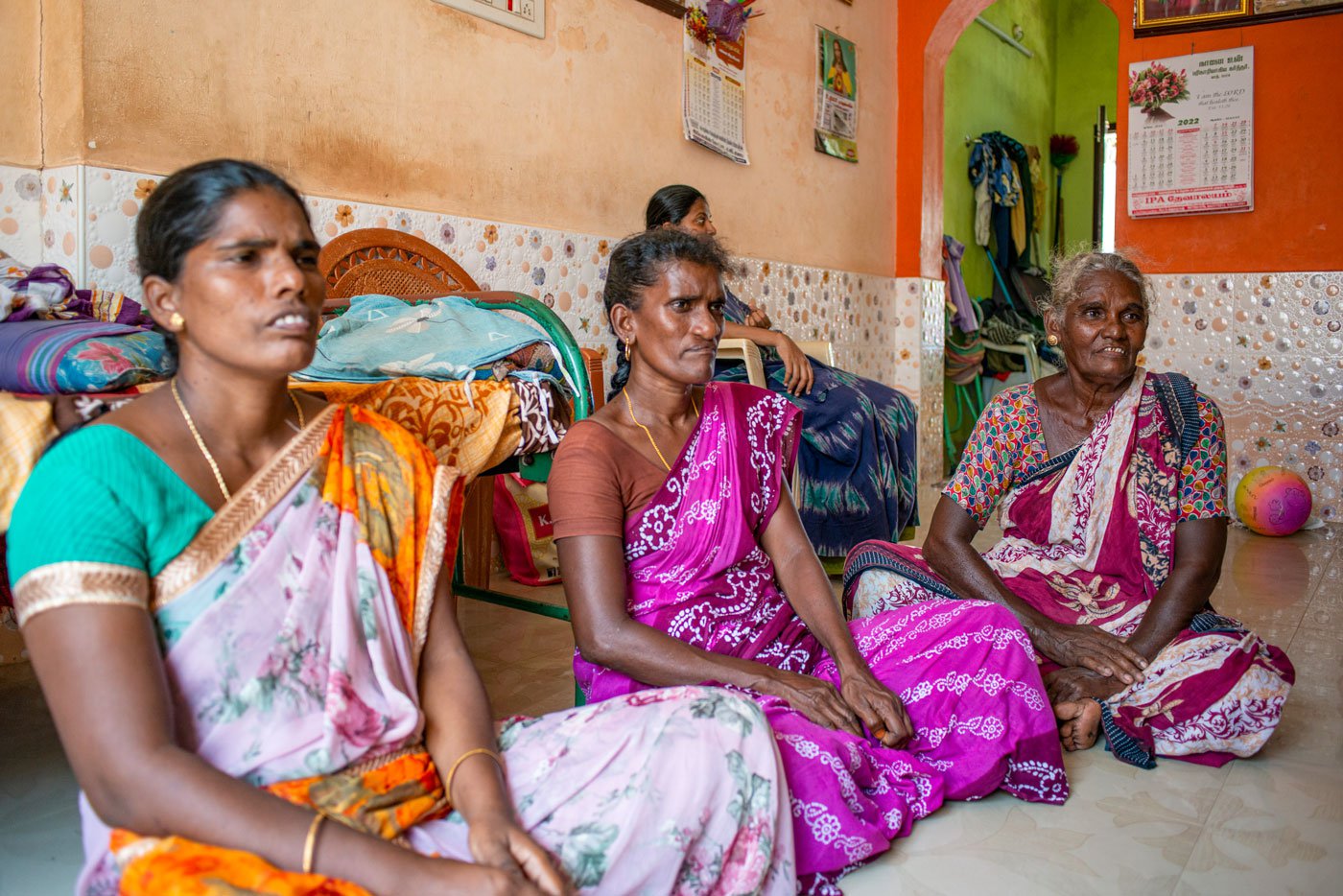
Left: A portrait of Sahayapurani. Right: Sahayapurani
and her daughters talk to PARI about the
Karuvadu
trade
The labour and returns in the karuvadu business are not equal. The fish that Sahayapurani bought that morning in the auction for 1,300 rupees [a basketful of saalai meen or sardines], will fetch her a profit of 500 rupees. For which she works two days, cleaning, salting and drying the fish, plus taking it in the bus over another two days to sell. That’s 125 rupees a day for her effort and time, isn’t it? I ask.
She nods her head simply. This time she does not smile.
*****
The picture of human resources and economics of the karuvadu trade in Thoothukudi is hazy. We get some figures from the Tamil Nadu marine fisheries census . Therespuram has 79 people involved in curing and processing fish, going up to 465 for all of Tuticorin district. Across the state, just nine per cent of all fisherfolk are in this line. However, out of this, a staggering 87 per cent are women. Significantly higher than the global figure in this FAO report , where the female workforce accounts for “half of the workers in the small-scale fisheries’ post-harvest sector.”
The profit and loss calculations are harder to come by. A large, five-kilo fish that would sell for a thousand rupees is given away for four hundred when it goes a little soft. The women call it ‘ gulugulu ,’ and demonstrate by pressing their fingers together, as if they’re squishing an imaginary creature. Rejected by fresh fish buyers, this is the stuff that karuvadu makers look for. They prefer it to the smaller fry, as the prep work takes less time.
Fathima’s big fish that weighed about five kilos took her an hour to get ready. An equivalent weight of smaller ones, she notes, would take her twice as long. The salt requirement also varies. Larger fish typically need half their body weight in salt. Smaller, firmer ones require one-eighth of their body weight.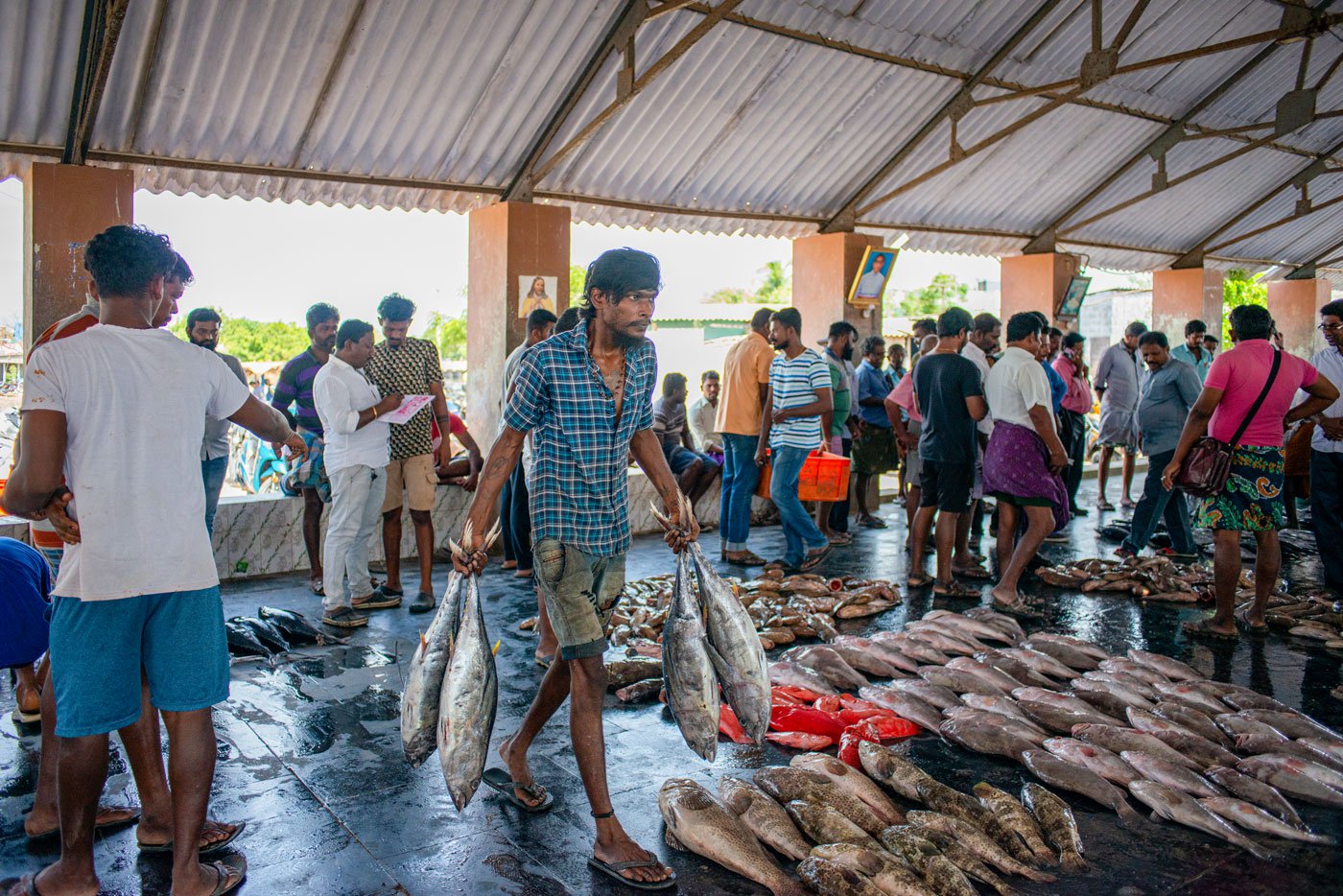
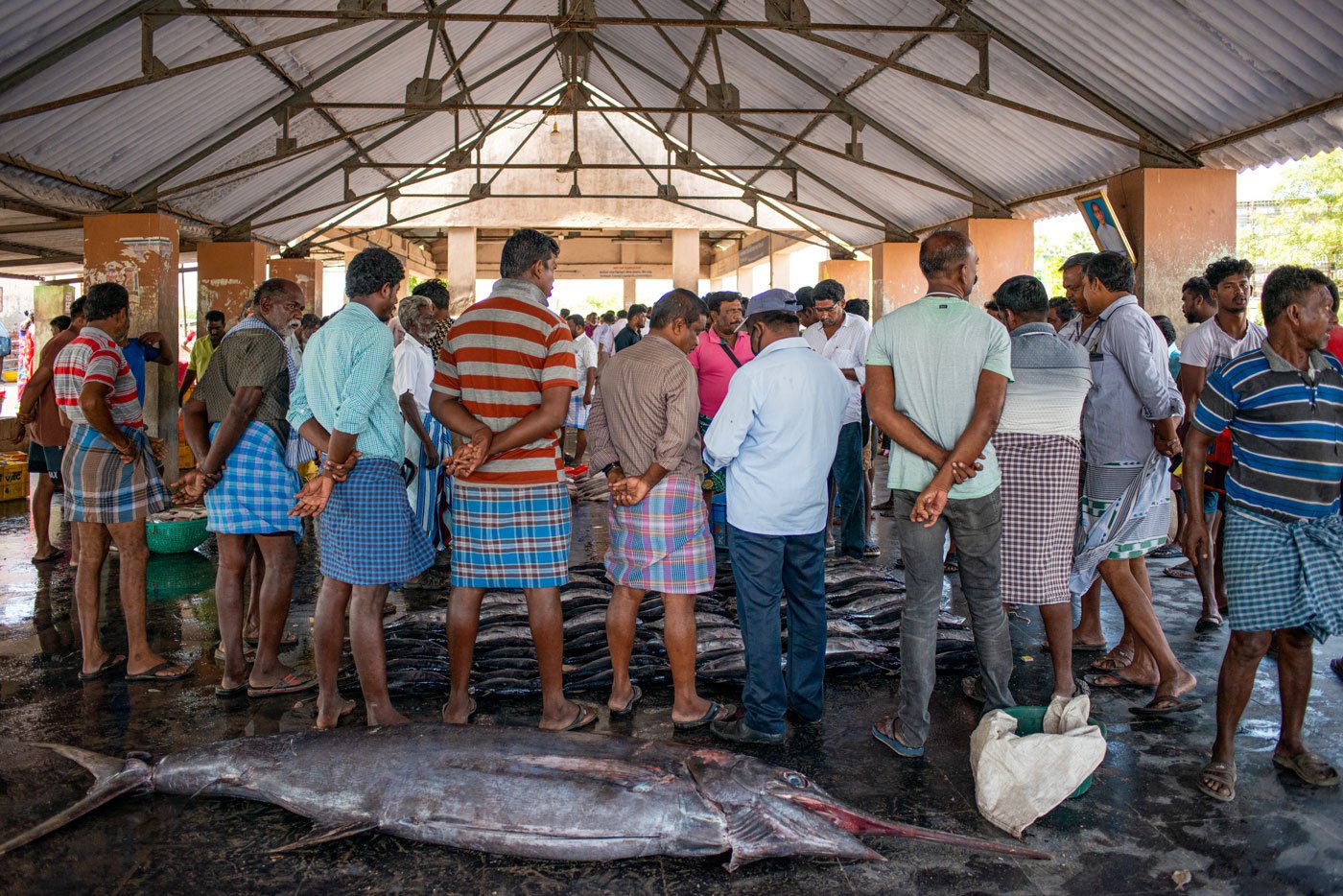
Scenes from Therespuram auction centre on a busy morning. Buyers and sellers crowd around the fish and each lot goes to the highest bidder

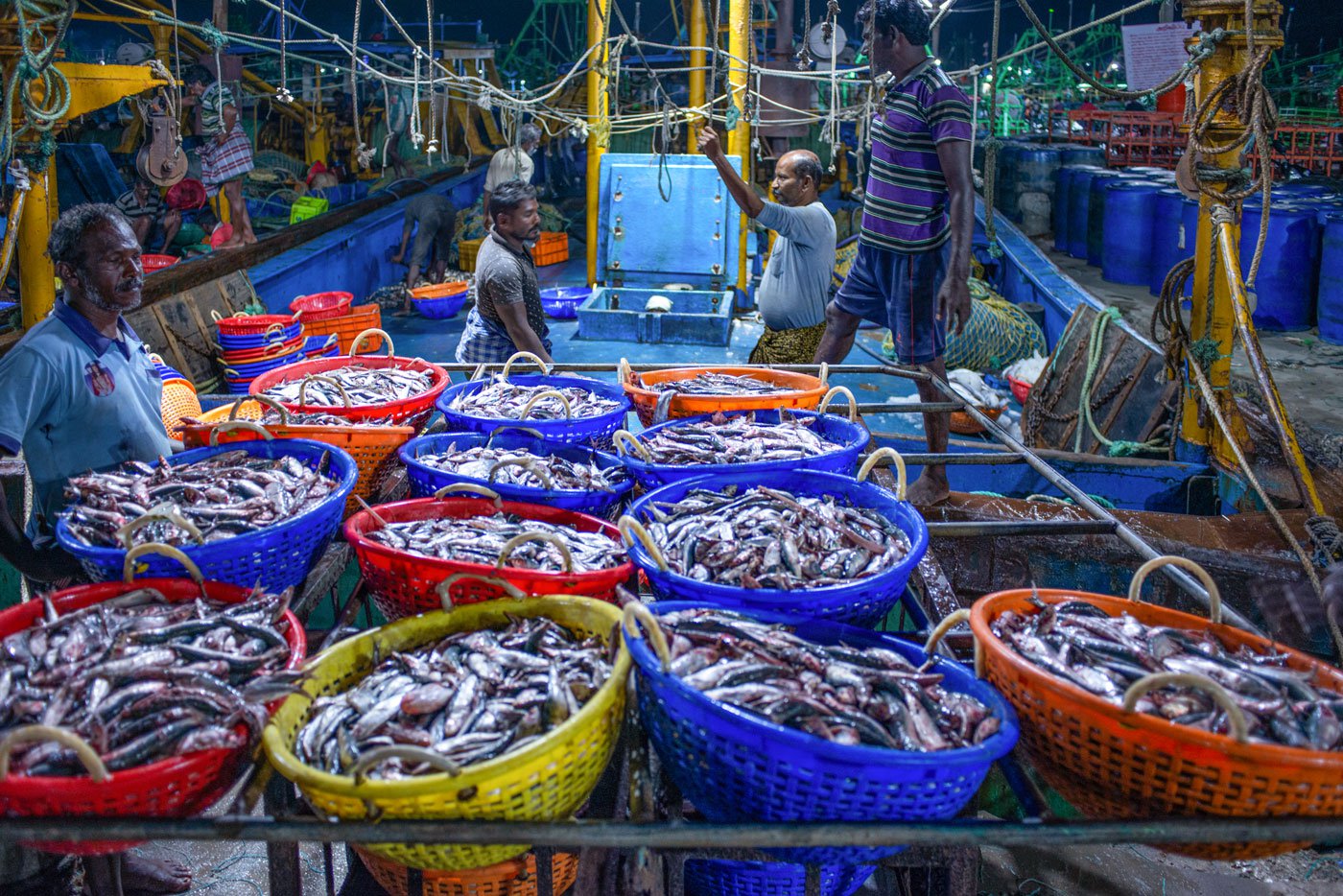
A woman vendor carrying fishes at the Therespuram auction centre on a busy morning. Right: At the main fishing Harbour in Tuticorin, the catch is brought l ate in the night. It is noisy and chaotic to an outsider, but organised and systematic to the regular buyers and sellers
The dried fish makers buy salt directly from the uppalam , or salt pans. The quantity varies – from a load that costs 1,000 rupees to those that go at 3,000 at a time, depending on how much they estimate they will use. They transport it in a tricycle or ‘ kuttiyaanai ’ (literally ‘small elephant,’ which is what a little tempo truck is called). And it is stored near their houses in tall blue plastic drums.
The procedure to make karuvadu hasn’t changed very much from her grandmother’s time, explains Fathima. The fish is gutted, cleaned, and the scales are scraped off. Then it is coated and stuffed with salt and sun dried. Their work is clean, she assures me, and shows me several baskets of fish. One has dried, chopped up karuvadu , marinated with turmeric powder. A kilo will sell for between 150 and 200 rupees. Another cloth bundle has ooli meen ( barracuda) and underneath, a plastic pail has dried saalai karuvadu (dried sardines). Her sister Frederique calls out from the next stall. “If our work is ‘ naakrey mookrey’ (sloppy and shoddy) will anybody buy it? Now, lots of big people – why, even the police – buy it from us. We’ve earned a name for our karuvadu .”
The sisters have also earned cuts and scrapes. Frederique shows me her hands. There are many knife cuts, some small, some deep; each one talks about her past, far more accurately than the lines on her palm might foretell her future.
“My brother-in-law fetches the fish, and four of us sisters dry and sell it,” says Fathima, sitting down in the shade, inside her stall. “He’s had four surgeries; he can’t go to the sea anymore. So, he buys the stock – worth a few thousand [rupees] – from Therespuram auction centre or the main fishing harbour in Thoothukudi. All the purchases are noted down in a card. My sisters and I buy fish from him, paying him a little commission, and then make it into karuvadu .” Fathima calls her brother-in-law as “ maapillai ,” which usually translates to son-in-law; and she refers to her sisters as “ ponnu ,” typically a term for a young girl.
All of them are over 60.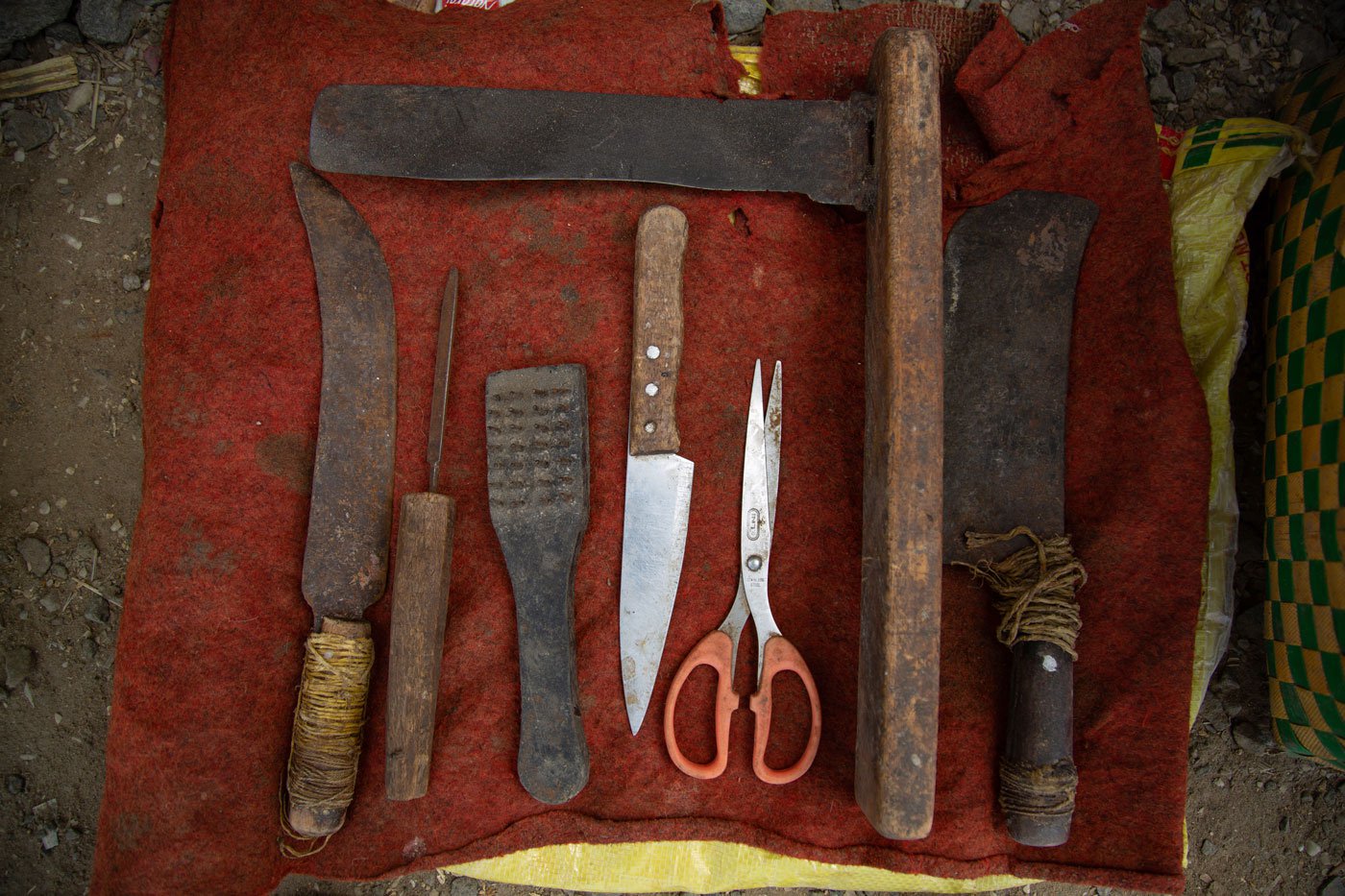
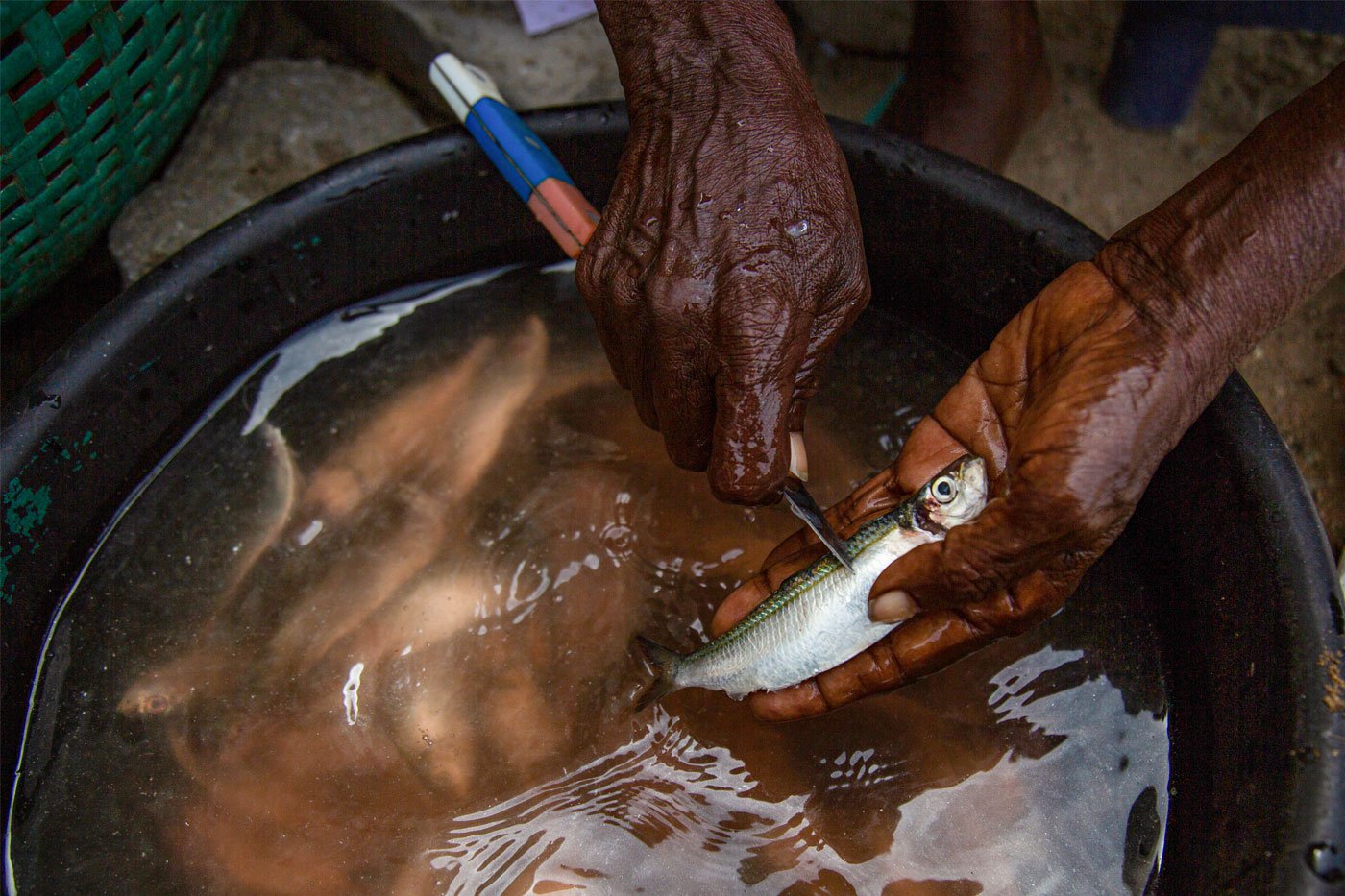
Left: All the different tools owned by Fathima . Right: Fathima cleaning the fish before drying them
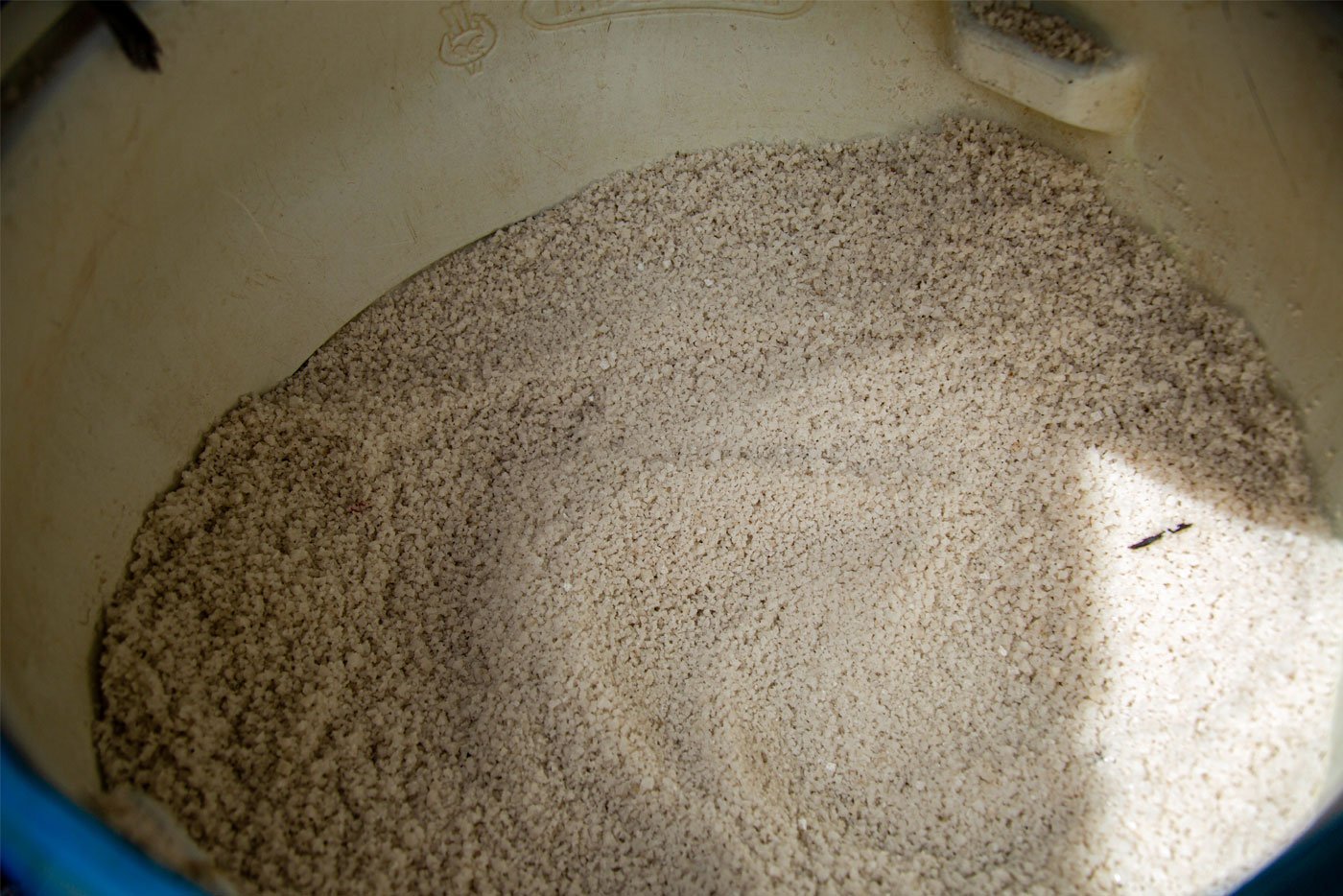
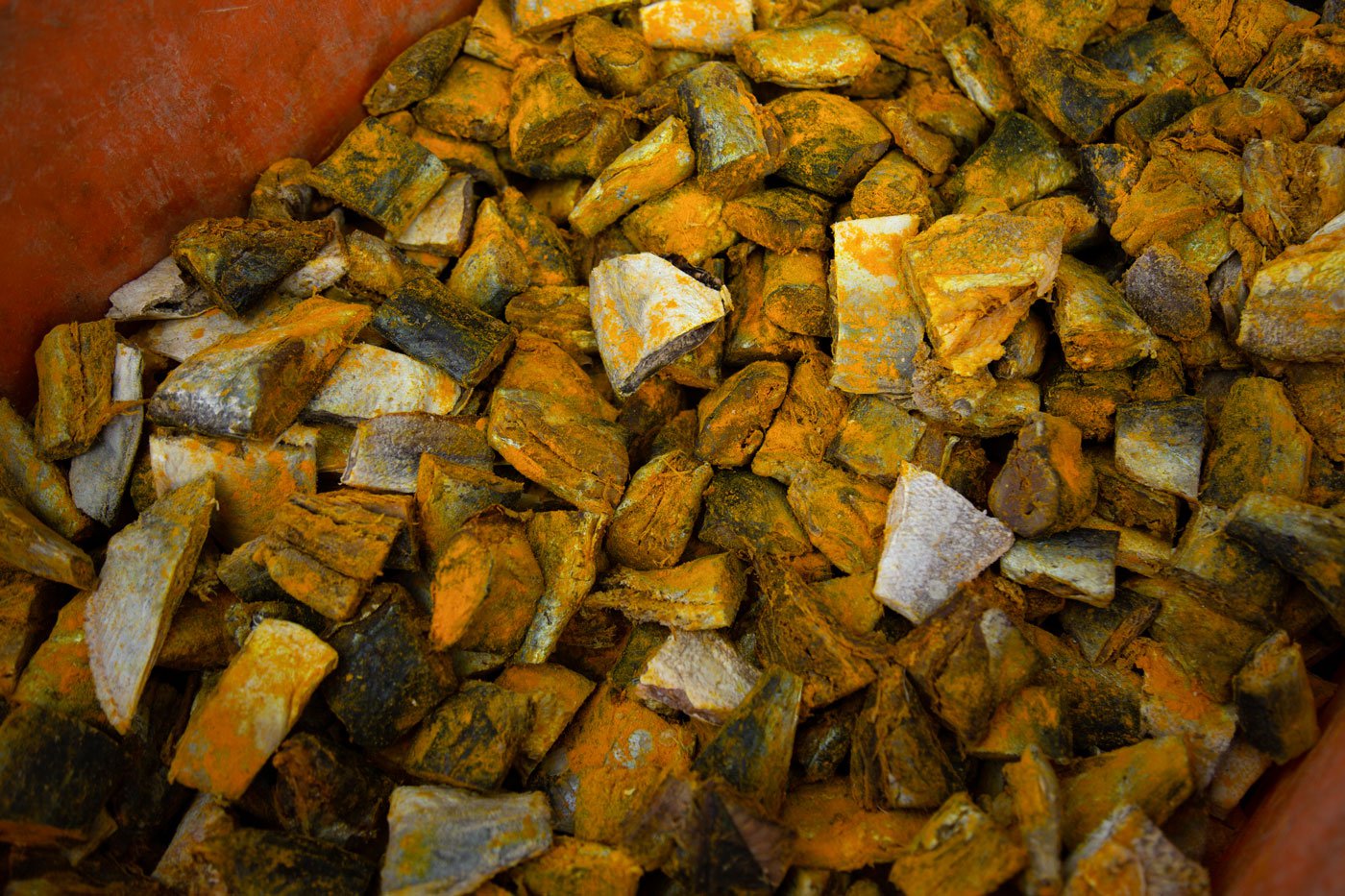
Left: Salt is stored in big blue plastic drums. Right: Dry fish is cut and coated with turmeric to preserve it further
Frederique uses a Tamil version of her name: Petri. She has worked as a single woman for 37 years. That is since her husband John Xavier – she too calls him maapillai – passed away. “During the rainy months, we can’t dry fish. And it gets very hard to make a living. We borrow money at steep interest rates – 5 paise and 10 paise on every rupee per month,” she says. That works out to 60 to 120 per cent interest over a year.
Seated by the side of the sluggish canal, outside the makeshift stall, Frederique says she wants a new ice box. “A big one, with a strong lid, in which we can store fresh fish and sell during the rainy months. Look, we can’t always borrow from our circles because everybody’s business is hit. Who has money? Sometimes, buying a milk packet is hard.”
The money from selling the dried fish goes towards the house, food, and health expenses. She stresses the last one – “pressure and sugar tablets” – and points out that during the months when the “launches” (fishing boats) are banned, they borrow money to buy food. “During April and May, fish spawn, and so fishing is not permitted. Our work suffers then. And also, during the monsoon – October to January – when it’s tough to procure salt, and dry the fish. We can’t save or keep aside money for the lean months.”
A new ice box costing about Rs. 4,500, a pair of iron weighing scales, plus an aluminium basket, is the kit Frederique believes will transform lives. “I’m not asking just for me; I want it for everybody. If we had that,” she says, “we can manage.”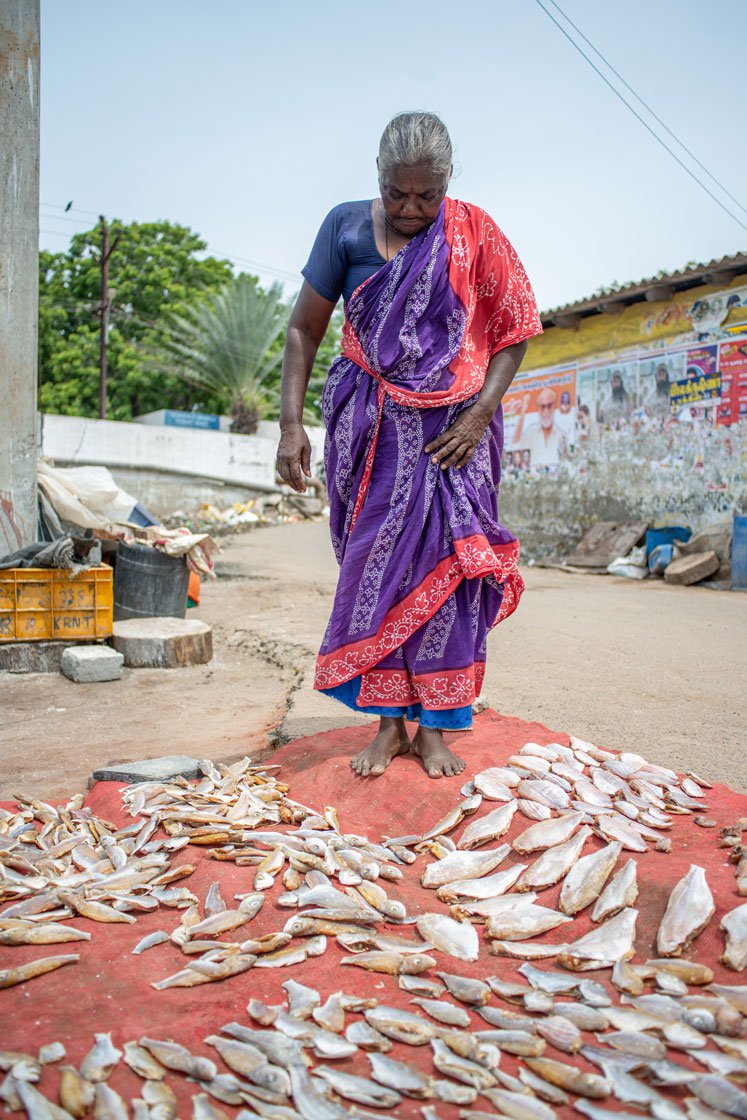
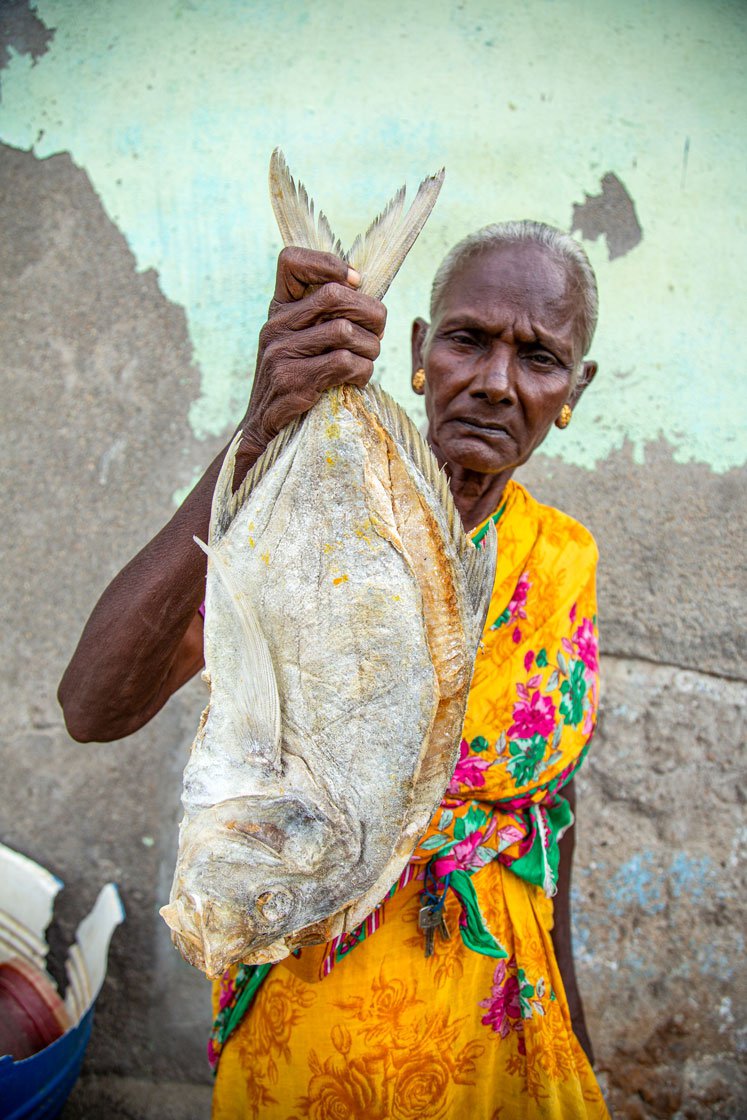
Left: Frederique with the fish she's drying near her house. Right: Fathima with a Paarai meen katuvadu (dried Trevally fish)
*****
Crops that are harvested and processed by hand – mostly by older women labourers, in the Tamil context – have a hidden/invisible cost: that of their time and underpaid labour.
Drying fish is no different.
“That kind of gendering of unremunerated labour is rampant in history. That is why so much of professionalization of worshipping, healing, cooking, educating, and provisioning, has gone hand in hand with acute forms of misogyny, marked by epithets such as witchcraft, old wives tales, witches' brew, etc,” explains Dr. Ray. In short, a whole heap of stereotypes and rationalisations for women’s unpaid labour. “That is not coincidental but essential to the making and unmaking of professions. That is why even today professional chefs tend to be almost caricatures of masculinity, claiming to be always upgrading home cooking. Priests did that before them. Physicians did that too. Professors did that too.”
On the other side of Thoothukudi town, in the kitchen of an artisanal salt maker, S. Rani, we see a live demo of karuvadu kozhambu (gravy). A year ago, in September 2021, we saw her harvesting salt from the pans, under a sun that scorched the earth and torched the water, producing gleaming crystals of salt.
The karuvadu Rani buys is made in her neighbourhood, with locally produced salt. To make the gravy, she soaks a lime-sized ball of tamarind in water. Then she breaks a coconut, and removes the flesh from one half, with the curved nose of a sickle. She dices it and puts it in an electric mixer, along with peeled small onions. She grinds it until it is like ‘silk.’ Rani chats as she prepares her meal. “ Karuvadu kozhambu ,” she says, looking up, “tastes good the next day too. It’s great to carry to work - with some porridge.”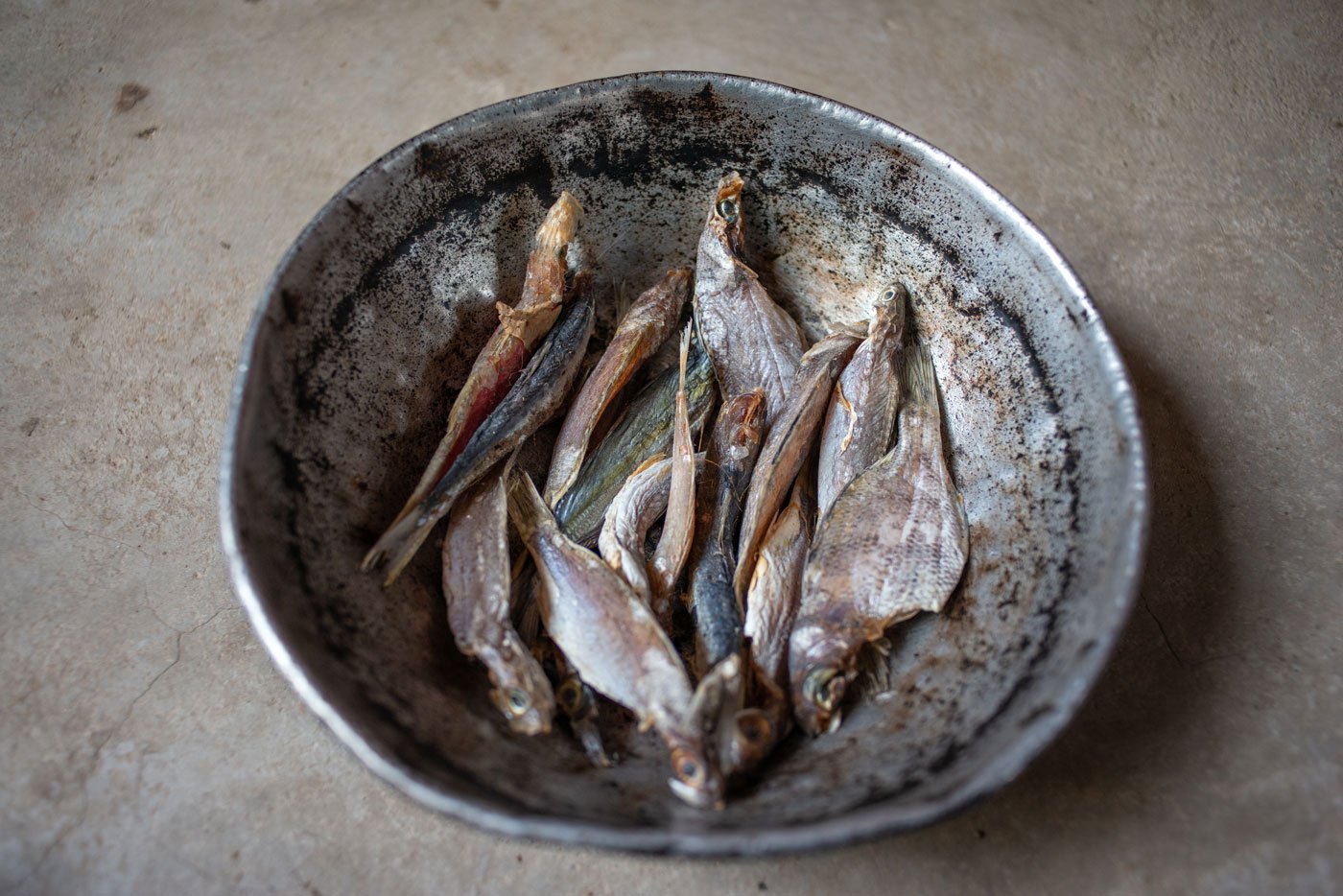
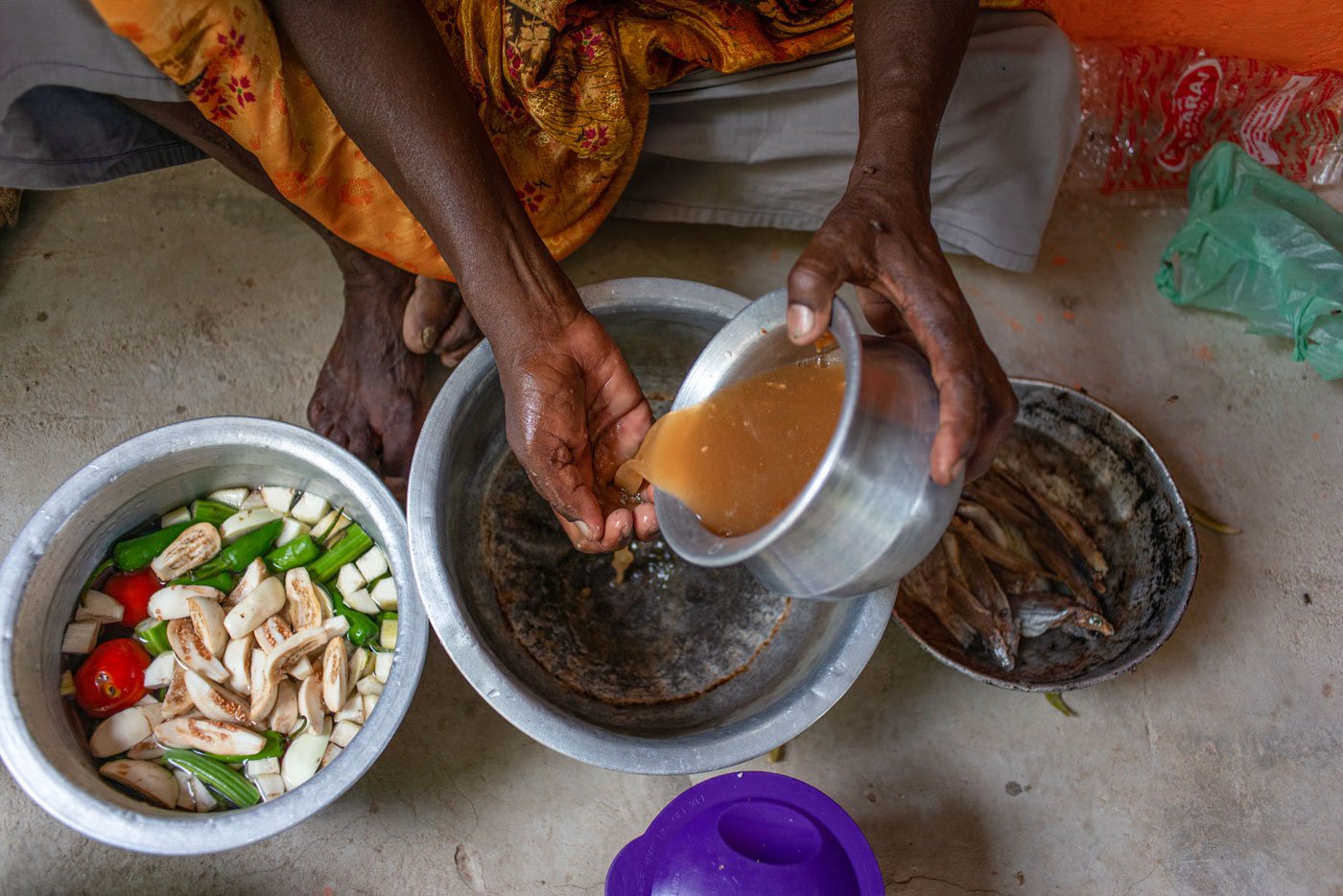
Left: A mixed batch of dry fish that will go into the day's dry fish gravy. Right: Tamarind is soaked and the pulp is extracted to make a tangy gravy
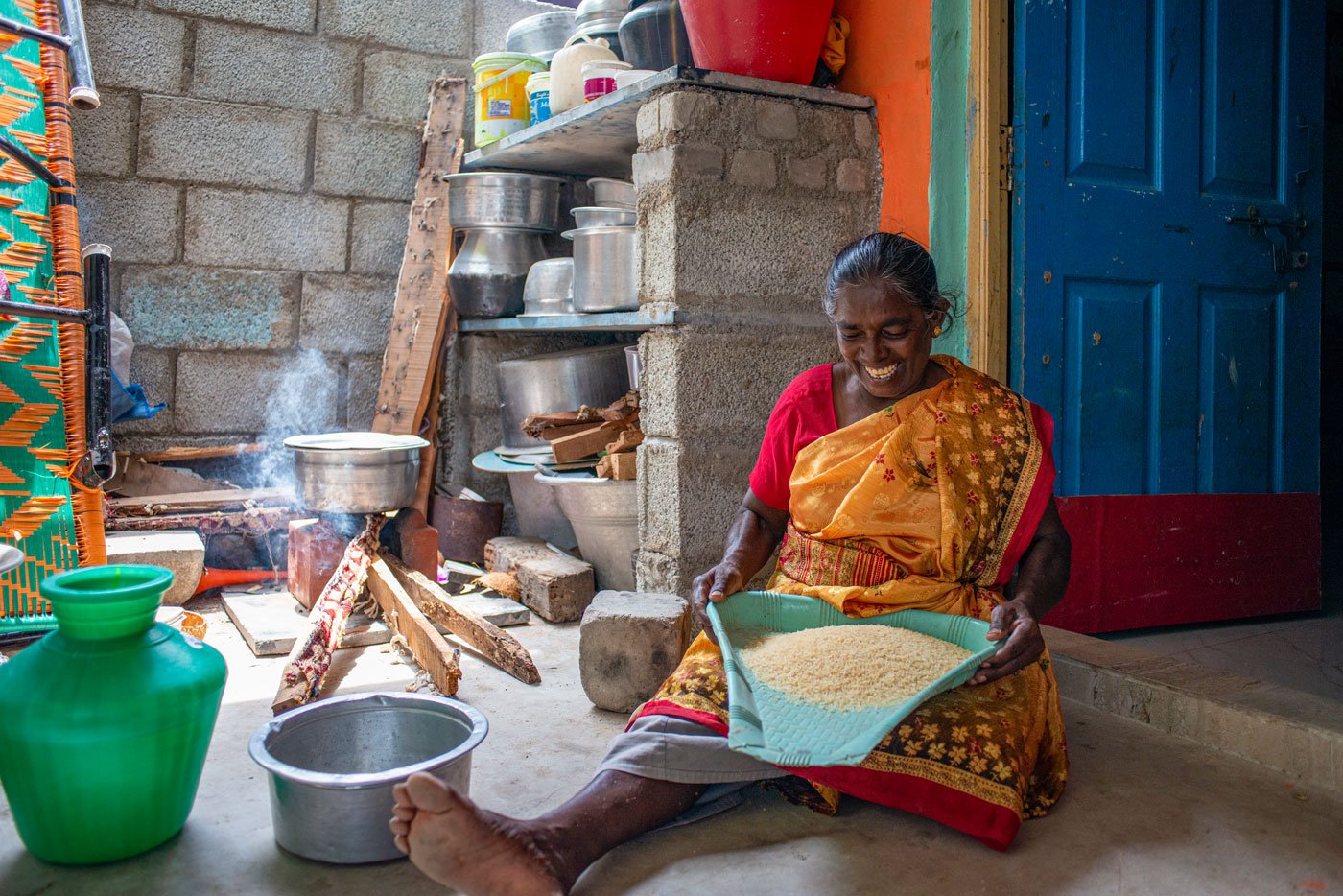
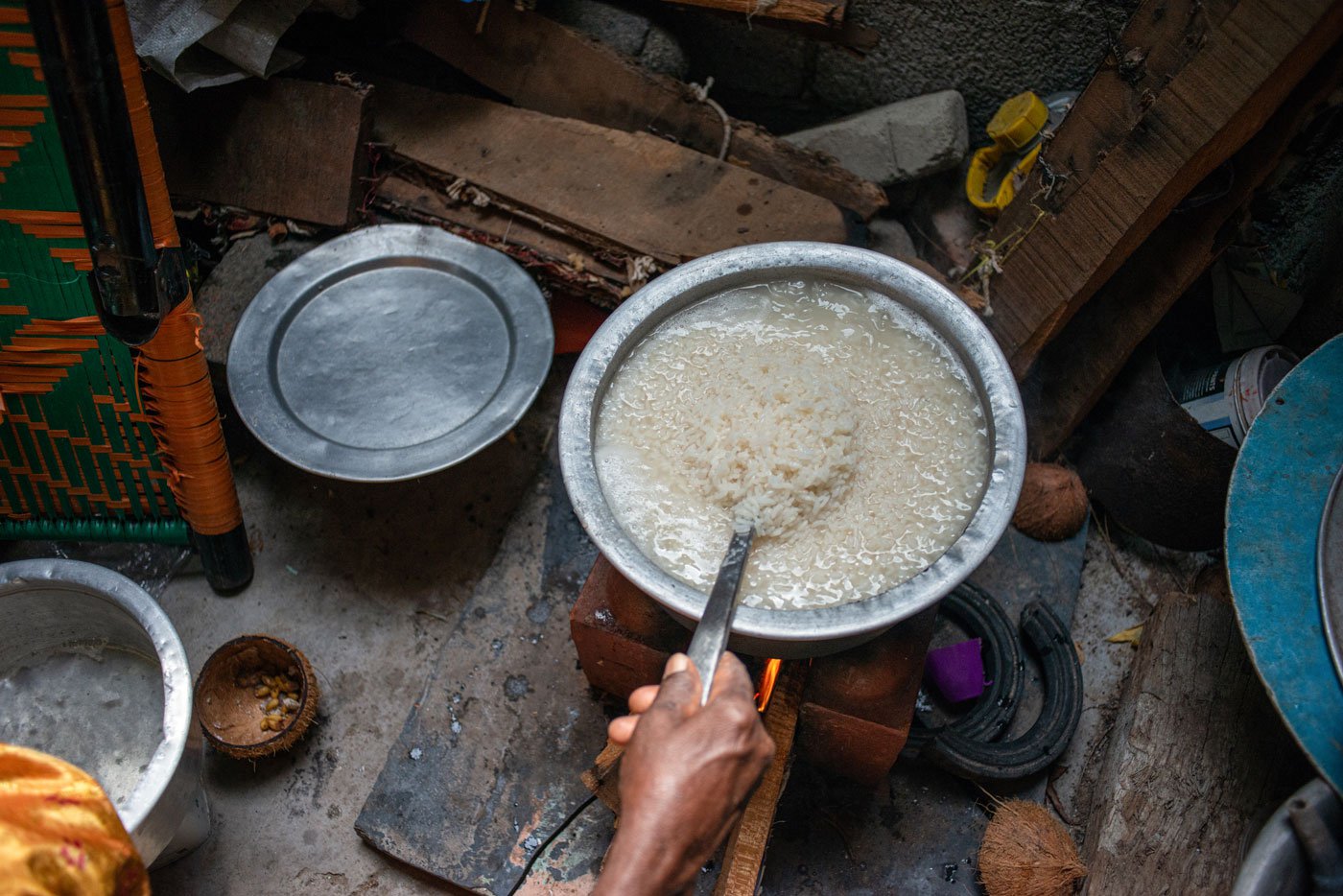
Left: Rani winnows the rice to remove any impurities. Right: It is then cooked over a firewood stove while the gravy is made inside the kitchen, over a gas stove
Next, she cleans and cuts the vegetables – two drumsticks, raw bananas, brinjals and three tomatoes. A few sprigs of curry leaves and a packet of masala powder complete the ingredient list. A cat meows hungrily, smelling the fish. Rani opens the packet, and pulls out many types of karuvadu – nagara, asalakutti, paarai and saalai . “I got this for forty rupees,” she says, and chooses about half of it for that day’s gravy.
There’s another preparation that she loves, Rani explains: karuvadu avial . She makes that with tamarind, green chili, onion, tomato and karuvadu . With a fantastic balance of spice, salt, and sourness, it’s a popular dish, and one that the workers take with them to the salt pans. Rani and her friends share more recipes. Cumin seeds, garlic, mustard and asafoetida are ground together and boiled in a soupy mixture of tamarind and tomato with some pepper and dried fish. “This,” Rani says, “is called milaguthanni. It is excellent for women who’ve just birthed a child, as it is full of medicinal spices.” Anecdotally, it is said to increase lactation. A version of milaguthanni minus the karuvadu is popularly known as rasam , even beyond Tamil Nadu. The British took this with them a long time ago, and it appears as a soup in many continental menus as ‘Mulligatawny.’
Rani drops the karuvadu in a vessel of water, and then cleans the fish. She removes the head and tail and fins. “Everybody here eats karuvadu ,” says Uma Maheshwari, a social worker. “Children eat it just like that. And some, like my husband, prefer it smoked.” The karuvadu is buried in the hot ash of a firewood stove, and when it is cooked well, it is eaten warm. “It smells so good. Sutta karuvadu is a delicacy,” Uma points out.
While the kozhambu boils, Rani sits on a plastic chair outside her house. We chat. I ask her about the unflattering representation of karuvadu in cinema. She smiles. “Some castes don’t eat meat. They are the ones who make films like that,” she says. “For some it is naatham [unpleasant smell]. For us, it is manam [a fine aroma].” And with that, the Rani of Thoothukudi’s salt pans settles the debate on karuvadu …
This research study is funded by Azim Premji University, Bengaluru, as part of their Research Funding Programme 2020.
